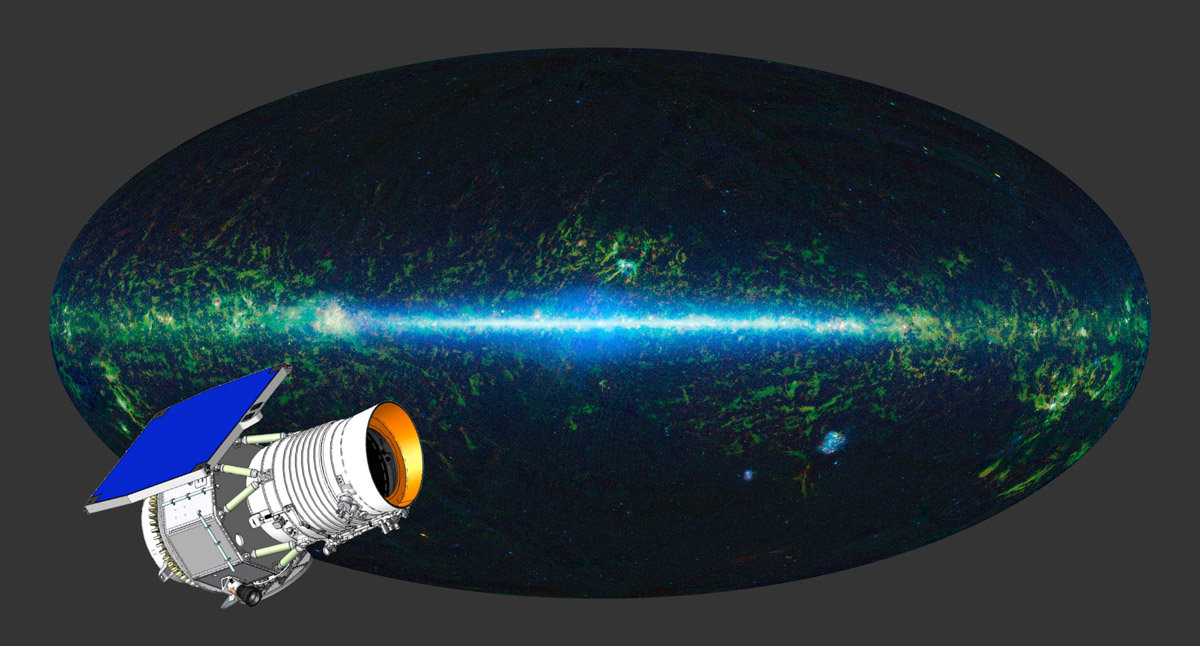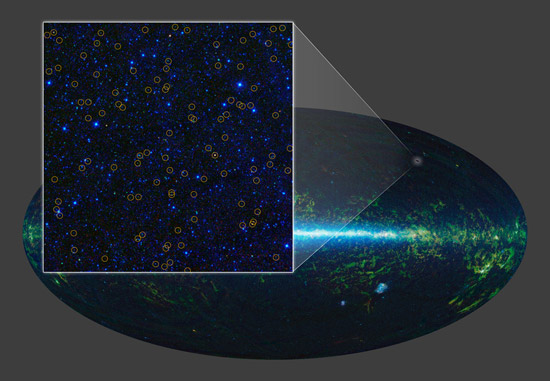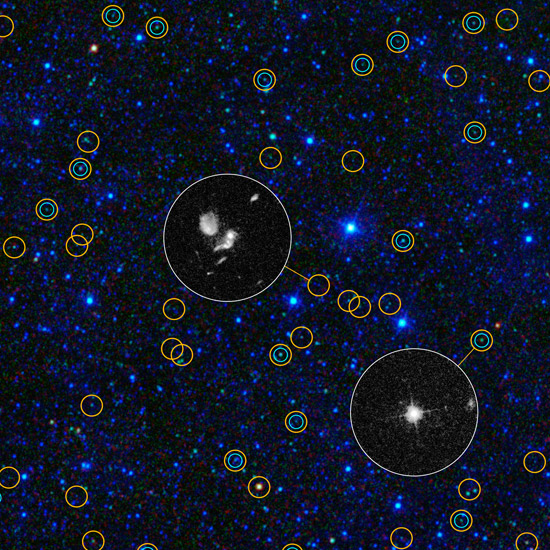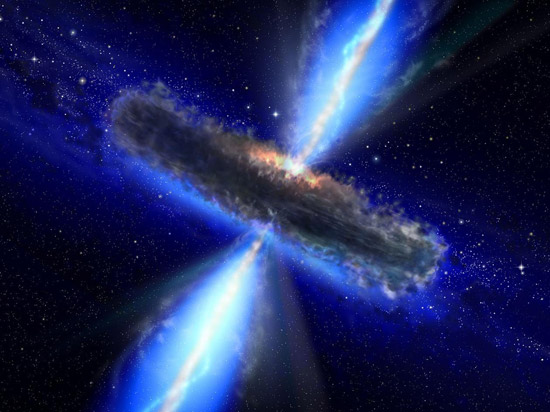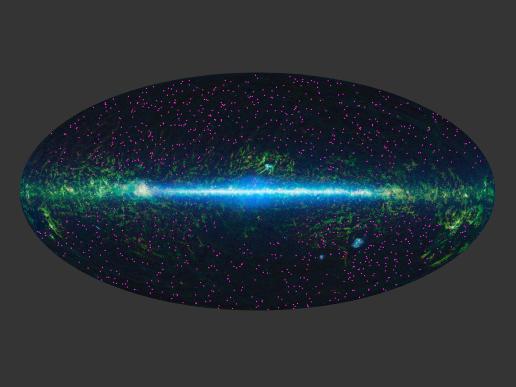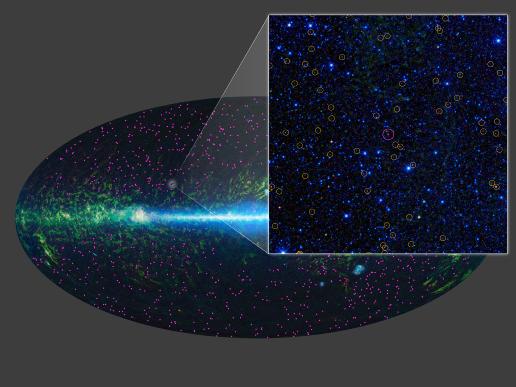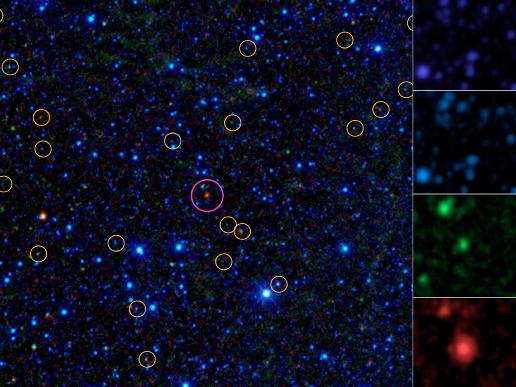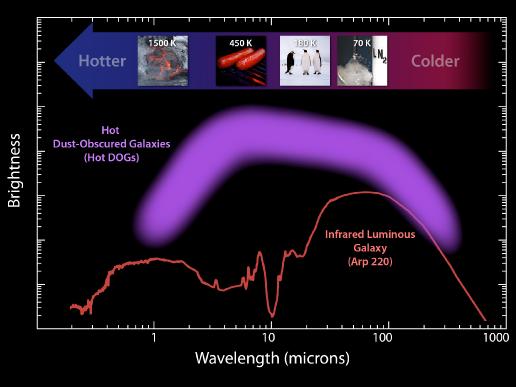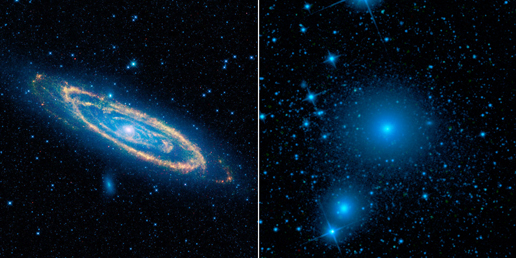



|
Aug. 29, 2012 - Black Holes and Extreme Objects 1. A WISE 'Eye' on the Whole Sky The entire sky as mapped by WISE at infrared wavelengths is shown here, with an artist's concept of the WISE satellite superimposed. Image credit: NASA/JPL-Caltech
2. A Sky Chock-Full of Black Holes With its all-sky infrared survey, NASA's Wide-field Infrared Survey Explorer, or WISE, has identified millions of quasar candidates. Quasars are super massive black holes with masses millions to billions times greater than our sun. The black holes "feed" off surrounding gas and dust, pulling the material onto them. As the material falls in on the black hole, it becomes extremely hot and extremely bright. This image zooms in on one small region of the WISE sky, covering an area about three times larger than the moon. The WISE quasar candidates are highlighted with yellow circles. Image credit: NASA/JPL-Caltech/UCLA
3. Exposing Black Holes Disguised in Dust This zoomed-in view of a portion of the all-sky survey from NASA's Wide-field Infrared Survey Explorer shows a collection of quasar candidates. Quasars are supermassive black holes feeding off gas and dust. The larger yellow circles show WISE quasar candidates; the smaller blue-green circles show quasars found in the previous visible-light Sloan Digital Sky Survey. WISE finds three times as many quasar candidates with a comparable brightness. Thanks to WISE's infrared vision, it picks up previously known bright quasars as well as large numbers of hidden, dusty quasars. The circular inset images, obtained with NASA's Hubble Space Telescope, show how the new WISE quasars differ from the quasars identified in visible light. Quasars selected in visible light look like stars, as shown in the lower right inset; the cross is a diffraction pattern caused by the bright point source of light. Quasars found by WISE often have more complex appearances, as seen in the Hubble inset near the center. This is because the quasars found by WISE are often obscured or hidden by dust, which blocks their visible light and allows the fainter host galaxy surrounding the black hole to be seen. Image credit: NASA/JPL-Caltech/UCLA/STScI
4. Quasar Drenched in Water Vapor This artist's concept illustrates a quasar, or feeding black hole, similar to APM 08279+5255, where astronomers discovered huge amounts of water vapor. Gas and dust likely form a torus around the central black hole, with clouds of charged gas above and below. X-rays emerge from the very central region, while thermal infrared radiation is emitted by dust throughout most of the torus. While this figure shows the quasar's torus approximately edge-on, the torus around APM 08279+5255 is likely positioned face-on from our point of view. Image credit: NASA/ESA
5. Galaxies Burn Bright Like High-Wattage 'Light Bulb' NASA's Wide-field Infrared Survey Explorer (WISE) has identified about 1,000 extremely obscured objects over the sky, as marked by the magenta symbols. These hot dust-obscured galaxies, or "hot DOGs," are turning out to be among the most luminous, or intrinsically bright objects known, in some cases putting out over 1,000 times more energy than our Milky Way galaxy.
6. Extremely Bright and Extremely Rare This image zooms in on the region around the first "hot DOG" (red object in magenta circle), discovered by NASA's Wide-field Infrared Survey Explorer, or WISE. Hot DOGs are hot dust-obscured galaxies. Follow-up observations with the W.M. Keck Observatory on Mauna Kea, Hawaii, show this source is over 10 billion light-years away. It puts out at least 37 trillion times as much energy as the sun.
7. Homing in on 'Hot Dogs' This image is a portion of the all-sky survey from NASA's Wide-field Infrared Survey Explorer, or WISE. It highlights the first of about 1,000 "hot DOGs" found by the mission (magenta circle). Hot DOGs are hot dust-obscured galaxies and are among the most powerful galaxies known. Yellow circles are active supermassive black holes found by WISE, which are much more common.
8. Analyzing Hot DOG Galaxies This plot illustrates the new population of "hot DOGs," or hot dust-obscured objects, found by WISE. The purple band represents the range of brightness observed for the extremely dusty objects. These powerful galaxies, which host active supermassive black holes at their cores, pour out enormous amounts of light at infrared wavelengths, while their visible light is blocked by dust.
9. Our Neighboring Galaxies, Andromeda and Fonax http://wise.ssl.berkeley.edu/gallery_andromeda.html 10.Starry Night Tango This simulation, which represents a few billion years of evolution, shows two disk galaxies interacting in a graceful gravitational dance. Video courtesy Volker Springel, Heidelberg University, Germany
|
||||||||||||||||
|
|
|||||||||||||||||
|
|||
